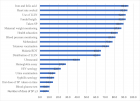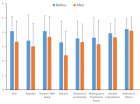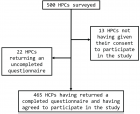Abstract
Review Article
Return to Driving in Mild Traumatic Brain Injury: Evaluation of Coping Strategies, Resilience, and Psychological Distress
Tisha J Ornstein*, Erica S Cuevas, Maire L O’Hagan and Samantha R Pejic
Published: 03 July, 2025 | Volume 9 - Issue 1 | Pages: 001-011
Background: This study explored whether emotional distress, coping, and/or resilience contributed to return to driving (RTD) following experienced mild traumatic brain injury, and whether these variables of interest differed among those who had and had not RTD.
Methods: The present study evaluated de-identified archival data of 65 patients with mTBI following an MVA. Patients were either the driver, passenger, /or pedestrian struck by a motor vehicle, and aged 22 to 69 years. The sample consisted of 36 men and 29 women with an average education. The mean months elapsed between the accident and the assessment was 16.82 months. Pearson correlations were used to test for associations between all explanatory and outcome variables. Separate linear and hierarchical regressions were carried out to evaluate whether variables of interest were significant predictors of RTD.
Results: Findings revealed that the presence of depressive symptoms was associated with coping, irrespective of style, resilience, driving-related anxiety, and RTD. Moreover, RTD was related to driving-related anxiety, too, and in fact, anxiety (considering the presence of depressive symptoms) appeared to be an even greater limiting factor when considering RTD in this population. Age, gender, and education did not influence RTD.
Conclusion: The present study revealed that depressive symptoms and driving-related anxiety in particular contribute to whether patients with mTBI RTD, irrespective of time since injury, age, and gender. Coping styles and resilience did not predict RTD. Further work is warranted to address the paucity of research investigating RTD parameters that contribute to and/or hinder RTD among mTBI sufferers.
Read Full Article HTML DOI: 10.29328/journal.ida.1001043 Cite this Article Read Full Article PDF
Keywords:
Return to driving; Mild traumatic brain injury; Coping styles; Resilience; Emotional distress
References
- Maas AIR, Menon DK, Adelson D, Andelic N, Bell MJ, Belli O. Traumatic brain injury: Integrated approaches to improve prevention, clinical care, and research. Lancet Neurol. 2017;16(12):987–1048. Available from: https://doi.org/10.1016/s1474-4422(17)30371-x
- Dewan MC, Rattani A, Gupta S, Baticulon RE, Hung YC, Punchak M, et al. Estimating the global incidence of traumatic brain injury. J Neurosurg. 2018;1–18. Available from: https://doi.org/10.3171/2017.10.jns17352
- Cullen N, Krakowski A, Taggart C. Early neuropsychological tests as correlates of return to driving after traumatic brain injury. Brain Inj. 2014;28(1):38–43. Available from: https://doi.org/10.3109/02699052.2013.849005
- Fleming J, Liddle J, Nalder E, Weir N, Cornwell P. Return to driving in the first 6 months of community integration after acquired brain injury. NeuroRehabilitation. 2014;34(1):157–166. Available from: https://doi.org/10.3233/nre-131012
- Gardner RC, Yaffe K. Epidemiology of mild traumatic brain injury and neurodegenerative disease. Mol Cell Neurosci. 2015;66(Pt B):75–80. Available from: https://doi.org/10.1016/j.mcn.2015.03.001
- Gozt AK, Hellewell SC, Thorne J, Thomas E, Buhagiar F, Markovic S, et al. Predicting outcome following mild traumatic brain injury: Protocol for the longitudinal, prospective, observational Concussion Recovery (CREST) cohort study. BMJ Open. 2021;11(5):e046460. Available from: https://doi.org/10.1136/bmjopen-2020-046460
- Tellier A, Della Malva L, Cwinn A, Grahovac S, Morrish W, Brennan-Barnes M. Mild head injury: a misnomer. Brain Inj. 1999;13(7):463–475. Available from: https://doi.org/10.1080/026990599121386
- Karr JE, Luoto TM, Gilman IG, Berghem K, Kotilainen AK, Iverson GL. Age, symptoms, and functional outcome after mild traumatic brain injury. Acta Neurol Scand. 2020;141(2):115–121. Available from: https://doi.org/10.1111/ane.13190
- Lamontagne G, Belleville G, Beaulieu-Bonneau S, Souesme G, Savard J, Sirois MJ, Ouellet MC. Anxiety symptoms and disorders in the first year after sustaining mild traumatic brain injury. Rehabil Psychol. 2022;67(1):90–99. Available from: https://doi.org/10.1037/rep0000422
- Nizamutdinov D, Shapiro LA. Overview of traumatic brain injury: An immunological context. Brain Sci. 2017;7(1):1–18. Available from: https://doi.org/10.3390/brainsci7010011
- McCrea M, Iverson GL, McAllister TW, Hammeke TA, Powell MR, Barr WB, et al. An integrated review of recovery after mild traumatic brain injury (MTBI): Implications for clinical management. Clin Neuropsychol. 2009;23(8):1368–1390. Available from: https://doi.org/10.1080/13854040903074652
- Riggio S, Wong M. Neurobehavioral sequelae of traumatic brain injury. Mt Sinai J Med. 2009;76(2):163–172. Available from: https://doi.org/10.1002/msj.20097
- Jorge RE, Arciniegas DB. Mood disorders after TBI. Psychiatr Clin North Am. 2014;37(1):13–29. Available from: https://doi.org/10.1016/j.psc.2013.11.005
- Jorge RE, Robinson RG, Starkstein SE, Arndt SV. Depression and anxiety following traumatic brain injury. J Neuropsychiatry Clin Neurosci. 1993;5(4):369–374. Available from: https://doi.org/10.1176/jnp.5.4.369
- Kiwanuka O, Lassaren P, Thelin EP, Hanell A, Sandblom G, Fagerdahl L, et al. Long-term health-related quality of life after trauma with and without traumatic brain injury: A prospective cohort study. Sci Rep. 2023;20(13):2986. Available from: https://doi.org/10.1038/s41598-023-30082-4
- Scholten AC, Haagsma JA, Andriessen TMJC, Vos PE, Steyerberg EW, van Beeck EF, et al. Health-related quality of life after mild, moderate and severe traumatic brain injury: patterns and predictors of suboptimal functioning during the first year after injury. Injury. 2015;46(4):616–624. Available from: https://doi.org/10.1016/j.injury.2014.10.064
- Ponsford JL, Downing MG, Olver J, Ponsford M, Acher R, Carty M, et al. Longitudinal follow-up of patients with traumatic brain injury: Outcome at two, five, and ten years postinjury. J Neurotrauma. 2014;31(1):64–77. Available from: https://doi.org/10.1089/neu.2013.2997
- Egeto P, Badovinac SD, Hutchison MG, Ornstein TJ, Schweizer TA. A systematic review and meta-analysis on the association between driving ability and neuropsychological test performances after moderate to severe traumatic brain injury. J Int Neuropsychol Soc. 2019;25(8):868–877. Available from: https://doi.org/10.1017/s1355617719000456
- Wardlaw C, Hicks AJ, Sherer M, Ponsford JL. Psychological resilience is associated with participant outcomes following mild to severe traumatic brain injury. Front Neurol. 2018;9:563. Available from: https://doi.org/10.3389/fneur.2018.00563
- Mallya S, Sutherland J, Pongracic S, Mainland B, Ornstein TJ. The manifestation of anxiety disorders after traumatic brain injury: A review. J Neurotrauma. 2015;32(7):411–421. Available from: https://doi.org/10.1089/neu.2014.3504
- Craig A, Tran Y, Guest R, Gopinath B, Jagnoor J, Bryant RA, et al. Psychological impact of injuries sustained in motor vehicle crashes: Systematic review and meta-analysis. BMJ Open. 2016;6(9):e011993. Available from: https://doi.org/10.1136/bmjopen-2016-011993
- Seel RT, MacCiocchi S, Kreutzer JS. Clinical considerations for the diagnosis of major depression after moderate to severe TBI. J Head Trauma Rehabil. 2010;25(2). Available from: https://doi.org/10.1097/htr.0b013e3181ce3966
- Koponen S, Taiminen T, Portin R, Himanen L, Isoniemi H, Heinonen H, et al. Axis I and II psychiatric disorders after traumatic brain injury: A 30-year follow-up study. Am J Psychiatry. 2002;159(8):1315–1321. Available from: https://doi.org/10.1176/appi.ajp.159.8.1315
- Bertisch HC, Long C, Langenbahn DM, Rath JF, Diller L, et al. Anxiety as a primary predictor of functional impairment after acquired brain injury: A brief report. Rehabil Psychol. 2013;58(4):429–435. Available from: https://doi.org/10.1037/a0034554
- Bryant R. Post-traumatic stress disorder vs traumatic brain injury. Dialogues Clin Neurosci. 2011;13(3):251–262. Available from: https://doi.org/10.31887/dcns.2011.13.2/rbryant
- Kuch K, Cox BJ, Evans R, Shulman I. Phobias, panic, and pain in 55 survivors of road vehicle accidents. J Anxiety Disord. 1994;8(2):181–188. Available from: https://doi.org/10.1016/0887-6185(94)90015-9
- Emanuelson I, Andersson Holmkvist E, Björklund R, Stålhammar D. Quality of life and postconcussion symptoms in adults after mild traumatic brain injury: A population-based study in western Sweden. Acta Neurol Scand. 2003;108(5):332–338. Available from: https://doi.org/10.1034/j.1600-0404.2003.00155.x
- Hibbard MR, Ashman TA, Spielman LA, Chun D, Charatz HJ, Melvin S. Relationship between depression and psychosocial functioning after traumatic brain injury. Arch Phys Med Rehabil. 2004;85(Suppl 2):S43–S50. Available from: https://doi.org/10.1016/j.apmr.2003.08.116
- Pagulayan KF, Hoffman JM, Temkin NR, Machamer JE, Dikmen SS. Functional limitations and depression after traumatic brain injury: Examination of the temporal relationship. Arch Phys Med Rehabil. 2008;89(10):1887–1892. Available from: https://doi.org/10.1016/j.apmr.2008.03.019
- Anson K, Ponsford J. Evaluation of a coping skills group following traumatic brain injury. Brain Inj. 2006;20(2):167–178. Available from: https://doi.org/10.1080/02699050500442956
- Backhaus SL, Ibarra SL, Klyce D, Trexler LE, Malec JF. Brain Injury Coping Skills Group: A preventative intervention for patients with brain injury and their caregivers. Arch Phys Med Rehabil. 2010;91(6):840–848. Available from: https://doi.org/10.1016/j.apmr.2010.03.015
- Mooney G, Speed J. Differential diagnosis in mild brain injury: Understanding the role of nonorganic conditions. NeuroRehabil. 2019;8(3):223–233. Available from: https://doi.org/10.3233/nre-1997-8308
- Sima AP, Yu H, Marwitz JH, Kolakowsky-Hayner SA, Felix ER, Bergquist TF, et al. Outcome prediction from post-injury resilience in patients with TBI. Rehabil Psychol. 2019;64(3). Available from: https://doi.org/10.1037/rep0000263
- Sullivan KA, Edmed SL, Allan AC, Smith SS, Karlsson LJE. The role of psychological resilience and mTBI as predictors of postconcussional syndrome symptomatology. Rehabil Psychol. 2015;60(2):147–154. Available from: https://doi.org/10.1037/rep0000037
- van der Naalt J, Timmerman ME, de Koning ME, van der Horn HJ, Scheenen ME, Jacobs B, et al. Early predictors of outcome after mild traumatic brain injury (UPFRONT): An observational cohort study. Lancet Neurol. 2017;16(7):532–540. Available from: https://www.thelancet.com/journals/laneur/article/PIIS1474-4422(17)30117-5/abstract
- Folkman S, Lazarus RS, Gruen RJ, DeLongis A. Appraisal, coping, health status, and psychological symptoms. J Pers Soc Psychol. 1986;50(3):571–579. Available from: https://doi.org/10.1037//0022-3514.50.3.571
- Mattlin JA, Wethington E, Kessler RC. Situational determinants of coping and coping effectiveness. J Health Soc Behav. 1990;31(1):103–122. Available from: https://pubmed.ncbi.nlm.nih.gov/2313073/
- Roth S, Cohen LJ. Approach, avoidance, and coping with stress. Am Psychol. 1986;41(7):813–819. Available from: https://doi.org/10.1037//0003-066x.41.7.813
- Endler NS, Parker JDA. Multidimensional assessment of coping: A critical evaluation. J Pers Soc Psychol. 1990;58(5):844–854. Available from: https://doi.org/10.1037//0022-3514.58.5.844
- Cohan SL, Jang KL, Stein MB. Confirmatory factor analysis of a short form of the Coping Inventory for Stressful Situations. J Clin Psychol. 2006;62(3):273–283. Available from: https://doi.org/10.1002/jclp.20211
- Krpan KM, Stuss DT, Anderson ND. Planful versus avoidant coping: Behavior of individuals with moderate-to-severe traumatic brain injury during a psychosocial stress test. J Int Neuropsychol Soc. 2011;17:248–255. Available from: https://doi.org/10.1017/s1355617710001499
- Finset A, Anderson S. Coping strategies in patients with acquired brain injury: The relationships between coping, apathy, depression and lesion location. Brain Inj. 2000;14(10):887–905. Available from: https://doi.org/10.1080/026990500445718
- Curran CA, Ponsford JL, Crowe S. Coping strategies and emotional outcome following traumatic brain injury: A comparison with orthopedic patients. J Head Trauma Rehabil. 2000;15(6):1256–1274. Available from: https://doi.org/10.1097/00001199-200012000-00006
- Southwick SM, Bonanno GA, Masten AS, Panter-Brick C, Yehuda R. Resilience definitions, theory, and challenges: Interdisciplinary perspectives. Eur J Psychotraumatol. 2014;5(1):1–14. Available from: https://doi.org/10.3402/ejpt.v5.25338
- Southwick SM, Charney DS. Resilience: The science of mastering life’s greatest challenges. Cambridge: Cambridge University Press; 2012. Available from: https://psycnet.apa.org/doi/10.1017/CBO9781139013857
- Burns RA, Anstey KJ. The Connor-Davidson Resilience Scale (CD-RISC): Testing the invariance of a unidimensional resilience measure that is independent of positive and negative affect. Pers Individ Dif. 2010;48(5):527–531. Available from: https://www.scirp.org/reference/referencespapers?referenceid=2704167
- Kralik D, van Loon A, Visentin K. Resilience in the chronic illness experience. Educ Action Res. 2006;14(2):187–201. Available from: https://research.sahmri.org.au/en/publications/resilience-in-the-chronic-illness-experience
- Rutter M. Psychosocial resilience and protective mechanisms. Am J Orthopsychiatry. 1987;57(3):316–331. Available from: https://doi.org/10.1111/j.1939-0025.1987.tb03541.x
- Smith BW, Dalen J, Wiggins K, Tooley E, Christopher P, Bernard J. The brief resilience scale: assessing the ability to bounce back. Int J Behav Med. 2008;15(3). Available from: https://doi.org/10.1080/10705500802222972
- Lukow HR, Godwin EE, Marwitz JH, Mills A, Hsu NH, Kreutzer JS. Relationship between resilience, adjustment, and psychological functioning after traumatic brain injury: A preliminary report. J Head Trauma Rehabil. 2015;30(4):241–248. Available from: https://doi.org/10.1097/htr.0000000000000137
- Dawson DR, Schwartz ML, Winocur G, Stuss DT. Return to productivity following traumatic brain injury: Cognitive, psychological, physical, spiritual, and environmental correlates. Disabil Rehabil. 2007;29(4):301–313. Available from: https://doi.org/10.1080/09638280600756687
- Rapport LJ, Wong CG, Hanks RA. Resilience and well-being after traumatic brain injury. Disabil Rehabil. 2020;42(14):2049–2055. Available from: https://doi.org/10.1080/09638288.2018.1552327
- Fisk GD, Schneider JJ, Novack TA. Driving following traumatic brain injury: Prevalence, exposure, advice and evaluations. Brain Inj. 1998;12(8):683–695. Available from: https://doi.org/10.1080/026990598122241
- Novack TA, Zhang Y, Kennedy R, Rapport LJ, Watanabe TK, Monden KR, et al. Return to driving after moderate-to-severe traumatic brain injury: A traumatic brain injury model system study. Arch Phys Med Rehabil. 2021;102(8):464–474. Available from: https://doi.org/10.1016/j.apmr.2021.02.006
- Pietrapiana P, Tamietto M, Torrini G, Mezzanato T, Rago R, Perino C. Role of premorbid factors in predicting safe return to driving after severe TBI. Brain Inj. 2005;19(3):192–211. Available from: https://doi.org/10.1080/02699050400017197
- Rapport LJ, Bryer RC, Hanks RA. Driving and community integration after traumatic brain injury. Arch Phys Med Rehabil. 2008;89(5):922–930. Available from: https://doi.org/10.1016/j.apmr.2008.01.009
- Liddle J, Fleming J, McKenna K, Turpin M, Whitelaw P, Allen S. Driving and driving cessation after traumatic brain injury: Processes and key times of need. Disabil Rehabil. 2011;33(25–26):2502–2510. Available from: https://doi.org/10.3109/09638288.2011.582922
- Heilbronner RL, Sweet JJ, Morgan JE, Larrabee GJ, Millis SR; Conference Participants. American Academy of Clinical Neuropsychology Consensus Conference Statement on the neuropsychological assessment of effort, response bias, and malingering. Clin Neuropsychol. 2009;23(7):1093–1129. Available from: https://doi.org/10.1080/13854040903155063
- Kay T. Neuropsychological treatment of mild traumatic brain injury. J Head Trauma Rehabil. 1993;8(3):74–85. Available from: https://journals.lww.com/headtraumarehab/toc/1993/09000
- Lovibond PF, Lovibond SH. The structure of negative emotional states: Comparison of the Depression Anxiety Stress Scales (DASS) with the Beck Depression and Anxiety Inventories. Behav Res Ther. 1995;33(3):335–343. Available from: https://doi.org/10.1016/0005-7967(94)00075-u
- Kuch K, Cox BJ, Direnfeld DM. A brief self-rating scale for PTSD after road vehicle accident. J Anxiety Disord. 1995;9(6):503–514. Available from: http://dx.doi.org/10.1016/0887-6185(95)00029-N
- Brands IMH, Köhler S, Stapert SZ, Wade DT, van Heugten CM. Psychometric properties of the Coping Inventory for Stressful Situations (CISS) in patients with acquired brain injury. Psychol Assess. 2014;26(3):848–856. Available from: https://doi.org/10.1037/a0036275
- Greene HA, Rapport LJ, Millis SR, Hanks RA, Williams MW. Rasch analysis of the Coping Inventory for Stressful Situations in individuals with moderate to severe traumatic brain injury. Arch Phys Med Rehabil. 2015;96(4):659–666. Available from: https://doi.org/10.1016/j.apmr.2014.11.006
- McWilliams LA, Cox BJ, Enns MW. Use of the Coping Inventory for Stressful Situations in a clinically depressed sample: Factor structure, personality correlates, and prediction of distress. J Clin Psychol. 2003;59:1371–1385. Available from: https://doi.org/10.1002/jclp.10080
- Rafnsson FD, Smari J, Windle M, Mears SA, Endler NS. Factor structure and psychometric characteristics of the Icelandic version of the coping inventory for stressful situations (CISS). Pers Individ Dif. 2006;40(6):1247–1258. Available from: https://www.scirp.org/reference/referencespapers?referenceid=1302092
- Rodríguez-Rey R, Alonso-Tapia J, Hernansaiz-Garrido H. Reliability and validity of the Brief Resilience Scale (BRS) Spanish Version. Psychol Assess. 2016;28(5):101–110. Available from: https://doi.org/10.1037/pas0000191
- da Silva-Sauer L, de la Torre-Luque A, Smith BW, Lins CMC, Andrade S, Fernández-Calvo B. Brief Resilience Scale (BRS) Portuguese version: Validity and metrics for the older adult population. Aging Ment Health. 2020;25(8):1554–1563. Available from: https://doi.org/10.1080/13607863.2020.1753015
- Antony MM, Cox BJ, Enns MW, Bieling PJ, Swinson RP. Psychometric properties of the 42-item and 21-item versions of the Depression Anxiety Stress Scales in clinical groups and a community sample. Psychol Assess. 1998;10(2):176–181. Available from: http://dx.doi.org/10.1037/1040-3590.10.2.176
- Beaufort IN, De Weert-Van Oene GH, Buwalda VAJ, de Leeuw JRJ, Goudriaan AE. The Depression, Anxiety and Stress Scale (DASS-21) as a screener for depression in substance use disorder inpatients: A pilot study. Eur Addict Res. 2017;23(5):260–268. Available from: https://doi.org/10.1159/000485182
- Gloster AT, Rhoades HM, Novy D, Klotsche J, Senior A, Kunik M, et al. Psychometric properties of the Depression Anxiety and Stress Scale-21 in older primary care patients. J Affect Disord. 2008;110(3):248–259. Available from: https://doi.org/10.1016/j.jad.2008.01.023
- Sydnor VJ, Bouix S, Pasternak O, Hartl E, Levin-Gleba L, Reid B, et al. Mild traumatic brain injury impacts associations between limbic system microstructure and post-traumatic stress disorder symptomatology. Neuroimage Clin. 2020;26:102190. Available from: https://doi.org/10.1016/j.nicl.2020.102190
- Dahm J, Wong D, Ponsford J. Validity of the Depression Anxiety Stress Scales in assessing depression and anxiety following traumatic brain injury. J Affect Disord. 2013;151:392–396. Available from: https://doi.org/10.1016/j.jad.2013.06.011
- Sutherland J, Middleton J, Ornstein TJ, Lawson K, Vickers K. Assessing accident phobia in mild traumatic brain injury: The accident fear questionnaire. Rehabil Psychol. 2016;61(3):317–327. Available from: https://doi.org/10.1037/rep0000090
- Smith GP, Burger GK. Detection of malingering: validation of the Structured Inventory of Malingered Symptomatology (SIMS). J Am Acad Psychiatry Law. 1997;25(2):183–189. Available from: https://pubmed.ncbi.nlm.nih.gov/9213290/
- Parks A, Gfeller J, Emmert N, Lammert H. Detecting feigned postconcussional and posttraumatic stress symptoms with the structured inventory of malingered symptomatology (SIMS). Appl Neuropsychol. 2017;24(5):1–10. Available from: https://doi.org/10.1080/23279095.2016.1189426
- Shura RD, Ord AS, Worthen M. Structured Inventory of Malingered Symptomatology: a psychometric review. Psychol Inj Law. 2022;15(1):64–78. Available from: https://link.springer.com/article/10.1007%2Fs12207-021-09432-y
- van Impelen A, Merckelbach H, Jelicic M, Merten T. The structured inventory of malingered symptomatology (SIMS): a systematic review and meta-analysis. Clin Neuropsychol. 2014;28(8):1336–1365. Available from: https://doi.org/10.1080/13854046.2014.984763
- Puente-López E, Pina D, Ruiz-Hernández JA, Llor-Esteban B. Diagnostic accuracy of the structured inventory of malingered symptomatology (SIMS) in motor vehicle accident patients. J Forensic Psychiatr Psychol. 2021;32(1):131–154. Available from: https://doi.org/10.1080/14789949.2020.1833073
- R Core Team. R: A language and environment for statistical computing. Vienna, Austria: R Foundation for Statistical Computing; 2021. Available from: https://www.R-project.org/
- Kim HJ, Park H, Juon HS. The mediating role of pain catastrophizing on the association between depression and pain severity and interference among elderly Asian immigrants with chronic pain. J Pain Res. 2021;14:737–745. Available from: https://doi.org/10.2147/JPR.S304440
- Orlovska S, Pedersen MS, Benros ME, Mortensen PD, Agerbo E, Nordentoft M. Head injury as a risk factor for psychiatric disorders: A nationwide register-based follow-up study of 113,906 persons with head injury. Am J Psychiatry. 2014;171:463–469. Available from: https://doi.org/10.1176/appi.ajp.2013.13020190
- Howlett JR, Nelson LD, Stein MB. Mental health consequences of traumatic brain injury. Biol Psychiatry. 2022;91(5):413–420. Available from: https://doi.org/10.1016/j.biopsych.2021.09.024
- Stocchetti N, Zanier ER. Chronic impact of traumatic brain injury on outcome and quality of life: a narrative review. Crit Care. 2016;20(1):148. Available from: https://doi.org/10.1186/s13054-016-1318-1
- Ownsworth T, Fleming J. The relative importance of metacognitive skills, emotional status, and executive function in psychosocial adjustment following acquired brain injury. J Head Trauma Rehabil. 2005;20(4):315–332. Available from: https://doi.org/10.1097/00001199-200507000-00004
- Brands I, Kohler S, Stapert S, Wade D, van Heugten C. Influence of self-efficacy and coping on quality of life and social participation after acquired brain injury: A 1-year follow-up study. Arch Phys Med Rehabil. 2014;95:2327–2334. Available from: https://doi.org/10.1016/j.apmr.2014.06.006
- Calderone A, Cardile D, De Luca R, Quartrone A, Corallo F, Calabrò RS. Cognitive, behavioral and psychiatric symptoms in patients with spinal cord injury: a scoping review. Front Psychiatry. 2024;15:1369714. Available from: https://doi.org/10.3389/fpsyt.2024.1369714
- Soo C, Tate RL. Psychological treatment for anxiety in people with traumatic brain injury. Cochrane Database Syst Rev. 2012;3:CD005239. Available from: https://doi.org/10.1002/14651858.cd005239.pub2
- Ponsford J, Nicole L, Wong D, McKay A, Haines K, Downing M, O’Donnell M. Factors associated with response to adapted cognitive behavioral therapy for anxiety and depression following traumatic brain injury. J Head Trauma Rehabil. 2020;35(2):117–126. Available from: https://doi.org/10.1097/htr.0000000000000510
- Rabinowitch AR, Arnett PA. Positive psychology perspective on traumatic brain injury recovery and rehabilitation. Appl Neuropsychol Adult. 2018;25:295–303. Available from: https://doi.org/10.1080/23279095.2018.1458514
- Mueller C, Wesenberg S, Nestmann F, Stubbs B, Bebbington P, Raymont V. Interventions to enhance coping after traumatic brain injury: A systematic review. Int J Ther Rehabil. 2018;25(3):107–120. Available from: http://dx.doi.org/10.12968/ijtr.2018.25.3.107
Figures:
Similar Articles
-
Identifying mothers experiencing emotional distress in the neonatal intensive care unit. Application of PPTSD questionnaire in a Greek NICU populationKarkani Anastasia*,Theodoraki Martha,Paraskeva Natasa,Kouros Pavlos Aristidis,Pantelis Perdikaris,Rosenblum Ouriel,Mazet Philippe. Identifying mothers experiencing emotional distress in the neonatal intensive care unit. Application of PPTSD questionnaire in a Greek NICU population. . 2022 doi: 10.29328/journal.ida.1001033; 6: 025-031
-
Return to Driving in Mild Traumatic Brain Injury: Evaluation of Coping Strategies, Resilience, and Psychological DistressTisha J Ornstein*,Erica S Cuevas,Maire L O’Hagan,Samantha R Pejic. Return to Driving in Mild Traumatic Brain Injury: Evaluation of Coping Strategies, Resilience, and Psychological Distress. . 2025 doi: 10.29328/journal.ida.1001043; 9: 001-011
Recently Viewed
-
Impact of Latex Sensitization on Asthma and Rhinitis Progression: A Study at Abidjan-Cocody University Hospital - Côte d’Ivoire (Progression of Asthma and Rhinitis related to Latex Sensitization)Dasse Sery Romuald*, KL Siransy, N Koffi, RO Yeboah, EK Nguessan, HA Adou, VP Goran-Kouacou, AU Assi, JY Seri, S Moussa, D Oura, CL Memel, H Koya, E Atoukoula. Impact of Latex Sensitization on Asthma and Rhinitis Progression: A Study at Abidjan-Cocody University Hospital - Côte d’Ivoire (Progression of Asthma and Rhinitis related to Latex Sensitization). Arch Asthma Allergy Immunol. 2024: doi: 10.29328/journal.aaai.1001035; 8: 007-012
-
SARS-CoV-2 antibody response to third dose vaccination in a healthy cohortSimmi Patel*,Sarah E Wheeler,Adam Anderson,Lisa Pinto,Michael R Shurin. SARS-CoV-2 antibody response to third dose vaccination in a healthy cohort. Insights Clin Cell Immunol. 2022: doi: 10.29328/journal.icci.1001020; 6: 008-013
-
Optimizing Treatment of Depression, Trauma, and Anxiety Disorders through Neurophysiological InterventionsKees Blasé*. Optimizing Treatment of Depression, Trauma, and Anxiety Disorders through Neurophysiological Interventions. Insights Depress Anxiety. 2025: doi: 10.29328/journal.ida.1001046; 9: 027-029
-
Investigating the Effect of the Family-Centered Empowerment Model (FCEM) on the Empowerment Indicators of Student Girls with Iron Deficiency Anemia (IDA) and Their MothersFatemeh Alhani,Hasan Navipor,Fatemeh Sadat Seyed Nematollah Roshan*. Investigating the Effect of the Family-Centered Empowerment Model (FCEM) on the Empowerment Indicators of Student Girls with Iron Deficiency Anemia (IDA) and Their Mothers. Insights Depress Anxiety. 2025: doi: 10.29328/journal.ida.1001045; 9: 017-024
-
The Bacteriological Profile of Nosocomial Infections at the Army Central Hospital of BrazzavilleMedard Amona*,Yolande Voumbo Matoumona Mavoungou,Hama Nemet Ondzotto,Benjamin Kokolo,Armel Itoua,Gilius Axel Aloumba,Pascal Ibata. The Bacteriological Profile of Nosocomial Infections at the Army Central Hospital of Brazzaville. Int J Clin Microbiol Biochem Technol. 2025: doi: 10.29328/journal.ijcmbt.1001032; 8: 009-022
Most Viewed
-
Impact of Latex Sensitization on Asthma and Rhinitis Progression: A Study at Abidjan-Cocody University Hospital - Côte d’Ivoire (Progression of Asthma and Rhinitis related to Latex Sensitization)Dasse Sery Romuald*, KL Siransy, N Koffi, RO Yeboah, EK Nguessan, HA Adou, VP Goran-Kouacou, AU Assi, JY Seri, S Moussa, D Oura, CL Memel, H Koya, E Atoukoula. Impact of Latex Sensitization on Asthma and Rhinitis Progression: A Study at Abidjan-Cocody University Hospital - Côte d’Ivoire (Progression of Asthma and Rhinitis related to Latex Sensitization). Arch Asthma Allergy Immunol. 2024 doi: 10.29328/journal.aaai.1001035; 8: 007-012
-
Causal Link between Human Blood Metabolites and Asthma: An Investigation Using Mendelian RandomizationYong-Qing Zhu, Xiao-Yan Meng, Jing-Hua Yang*. Causal Link between Human Blood Metabolites and Asthma: An Investigation Using Mendelian Randomization. Arch Asthma Allergy Immunol. 2023 doi: 10.29328/journal.aaai.1001032; 7: 012-022
-
An algorithm to safely manage oral food challenge in an office-based setting for children with multiple food allergiesNathalie Cottel,Aïcha Dieme,Véronique Orcel,Yannick Chantran,Mélisande Bourgoin-Heck,Jocelyne Just. An algorithm to safely manage oral food challenge in an office-based setting for children with multiple food allergies. Arch Asthma Allergy Immunol. 2021 doi: 10.29328/journal.aaai.1001027; 5: 030-037
-
Snow white: an allergic girl?Oreste Vittore Brenna*. Snow white: an allergic girl?. Arch Asthma Allergy Immunol. 2022 doi: 10.29328/journal.aaai.1001029; 6: 001-002
-
Cytokine intoxication as a model of cell apoptosis and predict of schizophrenia - like affective disordersElena Viktorovna Drozdova*. Cytokine intoxication as a model of cell apoptosis and predict of schizophrenia - like affective disorders. Arch Asthma Allergy Immunol. 2021 doi: 10.29328/journal.aaai.1001028; 5: 038-040

If you are already a member of our network and need to keep track of any developments regarding a question you have already submitted, click "take me to my Query."















































































































































